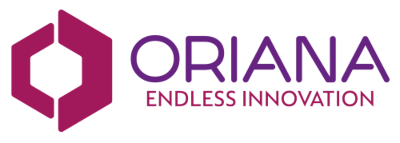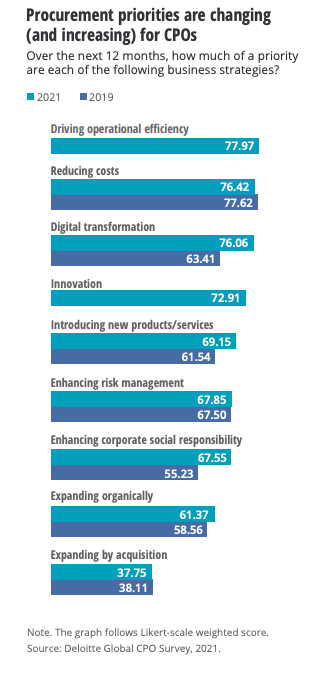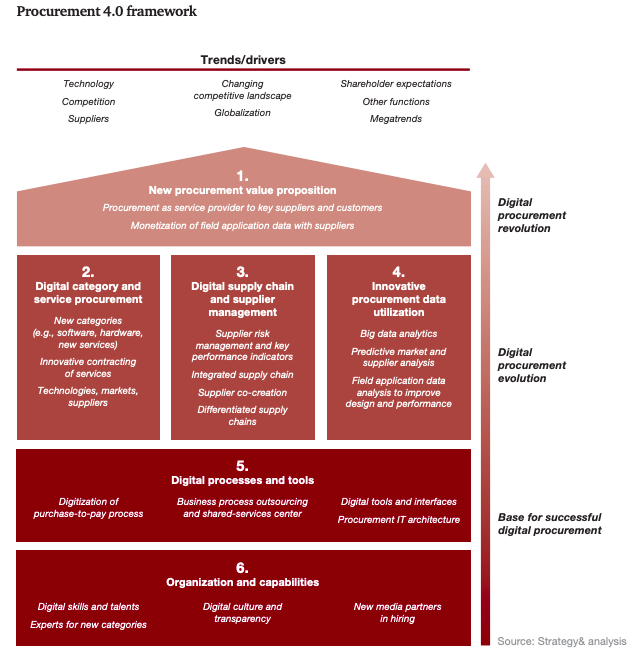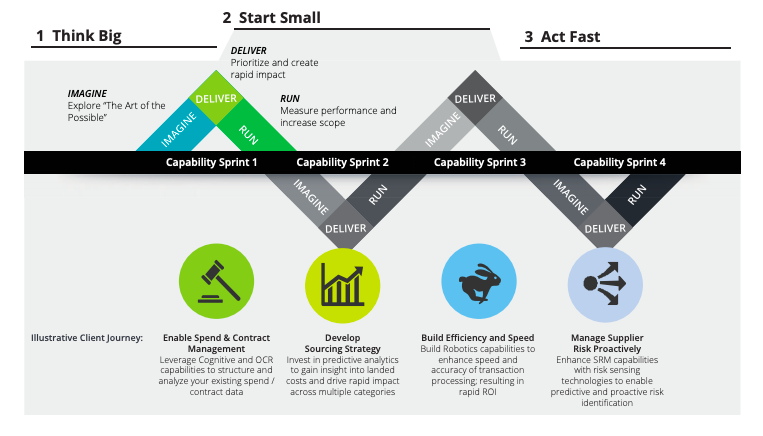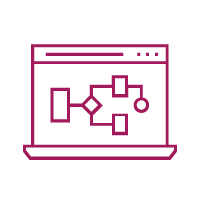Procurement professionals today are facing increasing pressure for cost reduction, supply chain continuity and more agile approaches to purchasing as technology brings opportunities to streamline processes and improve data insights.
This article aims to provide a high-level overview of why the change is needed and what the main challenges and benefits are. Procurement or process improvement leaders should read this to help understand how digitalising the procurement process can help stay competitive.
1. The future of procurement in the digital age
The procurement function plays a critical role in the success of any organisation. From sourcing to payment, finding and maintaining the best suppliers lies at the heart of operational excellence. As with other functions embracing digitalisation, it is no surprise that the procurement function needs to keep pace with the times. A digital procurement strategy across the entire supply chain can drive value improvements. It requires end-to-end digital processes to collect and analyse data and drive supplier development while ensuring fast and effective transaction of goods for the benefit of both sides. The future of procurement technology is placed front and centre of the people, processes and systems debate when setting up effective digitalised procurement as part of organisations digital transformation initiatives.
A recent survey by Deloitte shows operational efficiency at the top of Chief Procurement Officers (CPO) priorities alongside cost reduction, digital transformation, and innovation.
2. Major challenges in procurement and how to overcome them
Like all transformation initiatives, cultural, technical, and financial barriers exist. While the majority of organisations would testify to the value of digitalisation of their processes, a large number of organisations don’t have a cohesive strategy for how to get there. Added to that, the understanding of how AI/ML or RPA can be implemented is often lacking, leading to decisions to jump on the band wagon without fully understanding where they want to go. FOMO (Fear Of Missing Out) drives decision making in place of strategy and benefits.
Among the various procurement challenges faced, we have identified three worth exploring and looking at ways to overcome procurement challenges.
#1: Technical and Cultural Readiness
Embarking on a digital transformation of procurement processes opens up the larger question of the readiness of the organisation for change. Digital systems always have end-users and their understanding of the benefits to their daily tasks will be a huge factor in the adoption of new methods of work and the ability to convince suppliers to engage with new systems.
Additionally, the IT infrastructure of a complex organisation can be a limiting factor in how well a new system can be integrated to ensure data is shared between systems to support end-to-end process efficiency. Legacy systems and manual processes still prevail in many organisations, limiting process visibility with tacit knowledge dominating over data driven insights.
Solution:
The benefits of technology need to be communicated and education of employees made a priority. While certain roles may be at risk when digital systems come onboard, the wider benefit to the sustainability of the organisational function need to be explained. Digital expertise is required to be onboarded and developed to help identify opportunities across the supply chain and communicate credibly within the organisation.
Taking a step-by-step approach is wise. Look at the core processes before talking about AI and Machine Learning. Simplify where possible and focus on establishing the baseline to ensuring the procurement process from source to pay is transparent, consistent, and connected before implementing advanced technologies like AI/ML.
As PWC highlights in their Procurement 4.0 framework, organisational capability and digital processes and tools are the foundation for future procurement transformation.
Source: PWC, Procurement 4.0, Are you ready for the digital revolution?
#2: Budget and Urgency
Depending on the profile of the organisation, the procurement function may not receive the digitalisation focus required. Often customer facing initiatives come first. Hence, budgets and priorities may be directed elsewhere, leaving procurement lagging in the transition.
Solution:
Board room or leadership support is required to position procurement centrally for the improvement of satisfied customers and employees. With this support in place, data silos can be broken down and opportunities for improvement discussed, driving cost benefit analysis and budget allocation. Selecting a system or platform which can grow with the organisation from core processes towards more sophisticated technologies allows for easier adoption while offering a cost-effective approach.
#3: Strategy and Engagement
Many companies don’t have a robust strategy in place to support transformation across the organisation. Without this, stakeholder engagement can be lacking as it benefits are difficult to explain. Adoption of new processes and technologies will succeed or fail on the willingness of employees, leaders, and suppliers to use them.
Solution:
As with all change initiatives, a broad view and strategy roadmap will help communication to the wider organisation and external stakeholders. Supporting execution and driving engagement. Time is required to compare the as-is situation to the desired future scenario and looking for ways to transform in-line with a phased approach. Value creation should be in focus and doing more with available resources and technology is seen as a tool to support both. Involving suppliers in the process may be advised as they likely have experience in dealing with other customers facing similar challenges or better yet, ahead of you in the game.
Source: Deloitte, The Future of Procurement in the Age of Digital Supply Networks
3. The benefits of digitalising the procurement process
While obstacles exist, understanding the benefits will help to break them down. The overall aim is to work smarter and more effectively while optimising resources in the process. With technology as an enabler, we have picked three benefits to think about.
#1 Better Data and Insights
Clearly better decisions require better data. Technology supports the elimination of manual processes, reduces human error, and allows end-to-end process connectivity while logging activities. All this leads to the collection of vast amounts of valuable data regarding what purchasing decisions were made, how suppliers performed, when requisition patterns exist and where process bottlenecks exist. Collating this data is relatively easily today, providing management with better visibility across the supply chain to make more informed decisions.
#2 Compliance and Task Management
At the heart of all processes are human or robotic tasks. Digital workflows allow these tasks to be customised and standardised across the procurement process leading to a more consistent approach, driving compliance, and reducing rogue spending.
#3 Supplier and Employee Satisfaction
Automation in procurement processes can speed up the process and reduce human error while removing mundane and repetitive tasks. Freeing up employees to focus on more relationship and strategic activities.
Providing a solution where suppliers can be managed effectively and improve contract management will reduce clerical errors, help suppliers get paid on time. While at the same time offering them performance data to support their development.
4. How your procurement process can give you a competitive edge
Digitalising your procurement processes helps automate repetitive tasks, drive efficiency, and reduce costs. It gives business stakeholders real-time insights from data to support day-to-day decision making.
It improves buyer and supplier interactions and drives better collaboration through the supply chain. All this gives you the opportunity to streamline your procurement management process, freeing up valuable resources, reducing errors leading to back-office overload or simply doing more with less.
With the Oriana Procurement Solution, your digitalisation initiative grows with you. Whether you are taking your first digital procurement management steps or looking to replace an existing solution, our modular and customisable approach will offer flexibility and freedom to customise according to your specific business needs.
